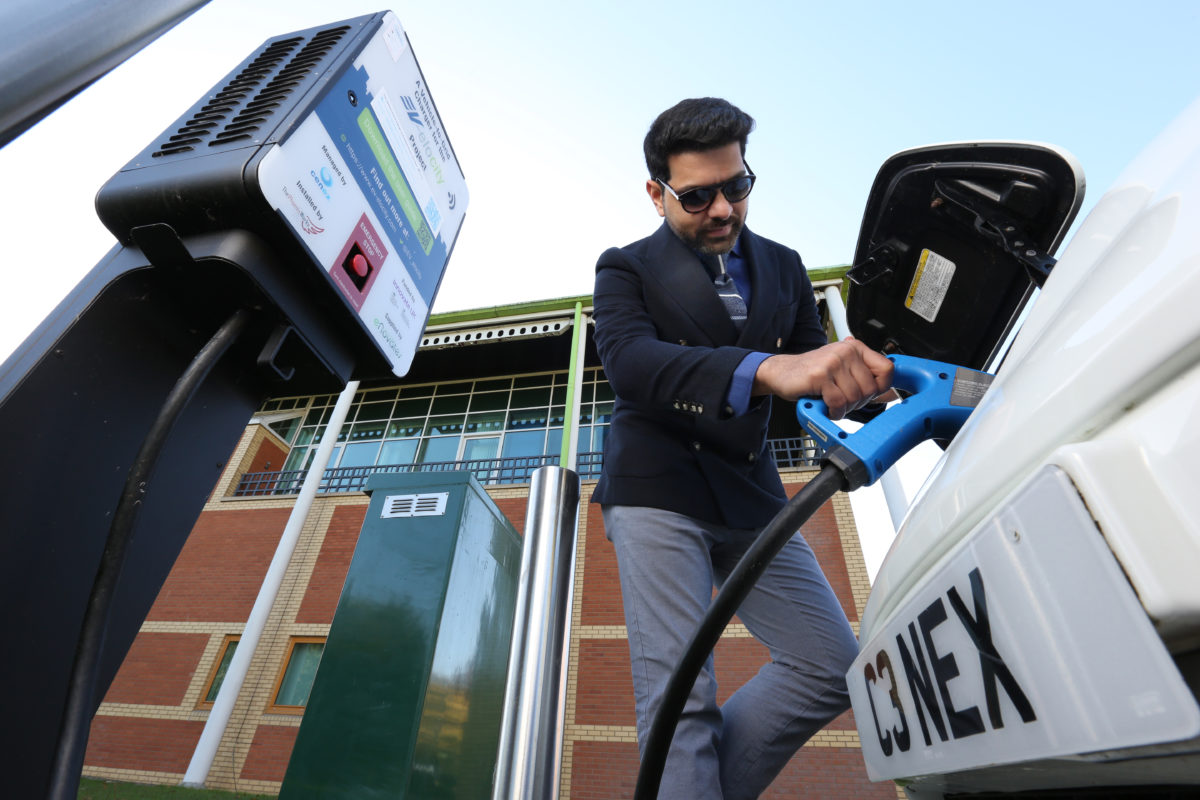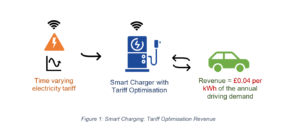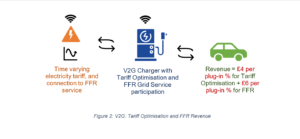
- Category:
- News
VEHICLE-TO-GRID: What’s it worth?
Sagar Mody, Technical Consultant- Infrastructure Strategy at Cenex, looks at the revenue available from V2G systems compared to smart charging.
Vehicle-to-grid (V2G) is a system whereby plug-in electric vehicles (EVs), when connected to a V2G charger, can provide bi-directional flows of energy and data. This technology enables EV batteries to be used as grid-connected energy storage. They can charge or discharge electrical energy in response to control signals. Two important requirements for V2G are to have a V2G compatible EV and a V2G compatible chargepoint.
Although V2G has come a very long way in the past decade, the technology is still in the research and trial stage. Several R&D trials have taken place which have been successful in installing and operating V2G in different settings. However, this is a technology that is still not available as a choice to everybody who might purchase a V2G compatible EV and chargepoint. There are several reasons for this, but the biggest one in my opinion is that there is no clear customer facing proposition for V2G, either from a domestic perspective or a fleet perspective. If a driver or fleet manager is interested in V2G, they will often have to knock on the door of experts or service providers and have meetings to try and understand what can be arranged.
Naturally, with so much effort involved, the question is: what is V2G worth?
In the last decade, the electric vehicles and energy industry have tried to answer it in various ways, with various case studies and academic studies. At Cenex we have been part of several R&D and trial projects which have looked at V2G from different perspectives: V2G for fleets, domestic V2G and even V2G as part of local energy networks. We published a free report in June 2020 which provided a fresh look at V2G value propositions. The report clearly shows that there are various value propositions to consider for V2G and not just revenue generating and energy trading. However, from a vehicle owner’s perspective, the revenue might be one of the most important benefits. So, is there a simple way to look at the revenue proposition for V2G?
Using our expertise and highly successful V2G model, REVOLVE we may have just found the simple rules of thumb for V2G we all wanted to know. We used REVOLVE to aid the concept design of a smart local energy system, GreenSCIES. GreenSCIES is an Innovate UK R&D project which is providing a detailed design for a local energy system in Islington, London. It combines low carbon technologies across heat, power and mobility. As part of the EV integration team, we modelled the potential for 11 kW smart chargers and V2G chargers across the network.
Here’s what we found:
Smart Charging
A smart charger can communicate with the EV and manage charging, in terms of time, power or both. If a smart charger has a price signal which varies over time, it can optimise the overall cost of charging by picking different times to charge. The value of tariff optimisation is driven by the annual energy demand of the vehicle using the chargepoint. Taking this into account, the rule of thumb that our study derived is that the tariff optimisation revenue at a smart chargepoint is 4p per kWh of the annual EV journey demand.
Let’s say an EV like a Nissan LEAF with a 40 kWh battery is being driven 8,000 miles a year. The manufacturer provided consumption is 275 Wh/mi which means the energy demand over the year would be approximately 2,200 kWh. The annual revenue potential of using a smart charger with a half hourly electricity price signal would therefore be approximately £88.
Vehicle to Grid
A V2G charger can do both smart charging and provide energy from the EV battery to the grid. Assuming that the owner has registered with an energy services provider and the chargepoint can participate in the ‘Firm Frequency Response’ (FFR) grid service, there is revenue potential in both tariff optimisation and FFR. For a V2G charger, the main driver for value is the amount of time that an EV is plugged into the chargepoint. Naturally, the more the EV is plugged in, the more it can fulfil its potential as a grid connected battery. This gives us the rule of thumb that the revenue for a V2G chargepoint is £4 per plug-in percentage for tariff optimisation, and an additional £6 per plug-in percentage for FFR services.
Let’s say the same LEAF with a 40 kWh battery is plugged-in to the V2G charger twice a week between 17.00 and 08.00. This means that it is plugged in for 30 hours per week and 1,560 hours per year. That’s 17.8% plug-in time per year. Based on this, the potential revenue will be £178.
What is all this based on?
The important things to note are as follows:
- All the chargers assumed in the modelling were 11 kW chargers. We assumed that the V2G chargers were able to fulfil the requirements to participate in the FFR service.
- Import and export electricity tariffs used were half hourly and based on 2019 spot electricity prices. These electricity prices are relevant to commercial customers. We used these since we were modelling the EV integration potential for a local energy network.
- FFR was the only grid service we considered with prices based on 2020 National Grid trial auctions.
In summary, a smart charger can save 4p per kWh of the annual energy demand of the vehicle by tariff optimisation, and a V2G charger can generate £4 from tariff optimisation and £6 from the FFR grid service per plug-in time percentage.
I hope that our findings demystify some of the questions around V2G and smart charging revenue. Although, there are several challenges still to overcome with regards to V2G, it is a technology that will be very useful as the world rapidly makes the shift to EVs.
If you are interested in V2G, please check out our FutureLearn ‘Vehicle-to-Grid Charging for Electric Cars’ course. It is free, CPD-accredited and is made with 16 years’ worth of our expertise in this industry.
Get in touch to see how Cenex can lower your emissions through innovation in Transport and Energy Infrastructure.

